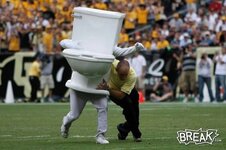hi guys
i have a gas-powered soldering iron that works just fine for my usual needs, which means wires on switches or coils, and maybe the occasional diode. now i'm considering taking the next step up, to soldering/desoldering a PCB. specifically, i want to desolder, remove, replace and resolder diode D3 on my System 11 Rollergames, as i've managed to convince myself this will help.
anyway. i know that probably my soldering iron isn't up the the job, but i also know that my soldering skills are *definitely* not up to the job, and i have never desoldered anything in my life. i bought a suction thingy and a have some of that copper braid stuff, but i just don't know how hot i can go or how close i can work with my butane iron.
so i want a scrap board i can happily feck up and nobody gets upset. i went to ebay, but (unless my search terms were way off) there's not much there, and the sellers want loadsamoney for it.
ideally either someone in London who could bring it to a meet (Matt's Surrey League, or the SE League which is in Camden at the dude's place in a fortnight) or the LPC at the pipeline on the 23rd. otherwise i'm happy to bung a few quid your way via cash or cheque or paypal if you have something you can stick in the post?
advice also very welcome. the butane iron has a hi-lo power sliding scale, so i'm assuming it should be at the shallow end?



i have a gas-powered soldering iron that works just fine for my usual needs, which means wires on switches or coils, and maybe the occasional diode. now i'm considering taking the next step up, to soldering/desoldering a PCB. specifically, i want to desolder, remove, replace and resolder diode D3 on my System 11 Rollergames, as i've managed to convince myself this will help.
anyway. i know that probably my soldering iron isn't up the the job, but i also know that my soldering skills are *definitely* not up to the job, and i have never desoldered anything in my life. i bought a suction thingy and a have some of that copper braid stuff, but i just don't know how hot i can go or how close i can work with my butane iron.
so i want a scrap board i can happily feck up and nobody gets upset. i went to ebay, but (unless my search terms were way off) there's not much there, and the sellers want loadsamoney for it.
ideally either someone in London who could bring it to a meet (Matt's Surrey League, or the SE League which is in Camden at the dude's place in a fortnight) or the LPC at the pipeline on the 23rd. otherwise i'm happy to bung a few quid your way via cash or cheque or paypal if you have something you can stick in the post?
advice also very welcome. the butane iron has a hi-lo power sliding scale, so i'm assuming it should be at the shallow end?




